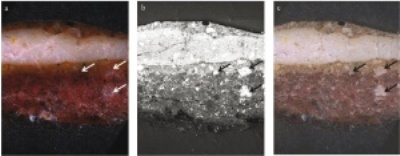Carl Zeiss has declared that the Indianapolis Museum of Art (IMA) is utilizing its Carl “Shuttle & Find” correlative microscopy package in the museum’s advanced conservation science lab sponsored by Lilly Endowment.
The package allows direct communication between ZEISS light microscopes and electron microscopes, hence considerably enhancing analysis of artwork samples. Each of the two microscopes provide specific ways to analyze and examine paintings and many other artworks. The challenge is to enable switching between these microscope types back and forth rapidly and accurately.
 CLEM (Correlative Light and Electron Microscopy) comparison of exact location on a cross-section sample with (a) darkfield, (b) BSE (Backscattered Electrons), and a (c) 50:50 mixture of darkfield and BSE images. Arrows indicate translucent particles (darkfield) containing lead (BSE). Credit: Business Wire
CLEM (Correlative Light and Electron Microscopy) comparison of exact location on a cross-section sample with (a) darkfield, (b) BSE (Backscattered Electrons), and a (c) 50:50 mixture of darkfield and BSE images. Arrows indicate translucent particles (darkfield) containing lead (BSE). Credit: Business Wire
The Shuttle & Find package comprises hardware and software components that include specialized adapters and a specimen holder for transferring the specimen normally a tiny paint sample that moves back and forth from the electron to the light microscope and vice versa. Together with this package, an OPMI Pico surgical microscope, a DISCOVERY V20 stereomicroscope, an AXIOIMAGER M2m compound microscope, and an EVO MA 15 scanning electron microscope have been installed by IMA from Carl Zeiss. All these equipments will provide updating of the museum’s long-term serving ZEISS polarized light microscope installed since 1970.
The Shuttle & Find software interface allows easy and rapid relocation of the interested area, completely using the abilities of light and electron microscope technologies. Traditional light microscope allows a rapid outlook of the specimen and several distinct technologies, for example dark/bright field, fluorescence, polarization, and color. However, the resolution is higher by two orders of magnitude with the electron microscope, and it provides expanded analytical features, for example energy dispersive x-ray spectroscopy (EDS) for characterization of the chemical composition of the sample. Hence it is possible for researchers to precisely cover the images of electron microscopy and light microscopy by utilizing the Shuttle & Find package that provides total data on the sample in a single visual field.